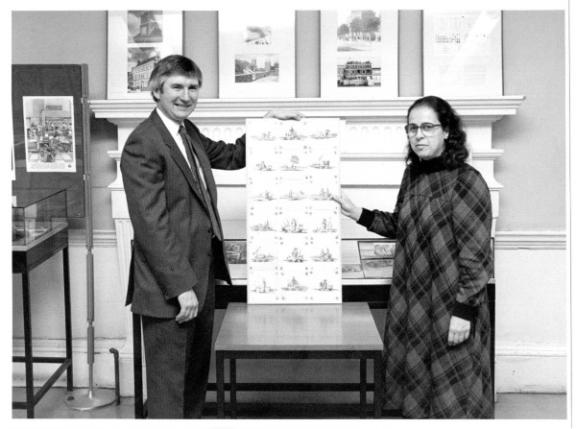History on Parade: Northumberland Row
There is an exceptional range of buildings of great architectural and social interest stretching all along historic Tottenham High Road. Of particular note are the group of buildings in and around Northumberland Row (or Northumberland Terrace), just south of Northumberland Park and to the north of the new Tottenham Hotspur stadium. Amongst this group are three magnificent houses called Dial House, Percy House and Holly House. All three of these buildings mentioned here form part of the Tottenham Hotspur Heritage Trail. You can see the trail mapped on a plan and scrolling down you can explore more of the information about other historical buildings.
Dial House - 790 Tottenham High Road
Look up high and you can see why this house has got its name. Positioned on the south side of the end chimney and gable is a wonderful sundial. It has helped passers-by tell the time since 1691. The date inscribed was when the house was built for soap manufacturer Moses Trulock. Dial House remained in the Trulock family until the 1830s.

(Detail of Sundial on south side gable of Dial House. From the collections and © Bruce Castle Museum and Archive)
After the building was damaged by fire in 1976, the Grade II* listed Dial House underwent a significant refurbishment by the Metropolitan Housing Trust. Much of the interior of the house was damaged, but amongst those objects that survived were a delightful collection of 17th century tin-glazed (Delftware) tiles that once adorned a fire-surround. The tiles are amongst the highlights now on display at Bruce Castle Museum and Archive where they were donated.

(Delft tiles from Dial House, High Road Tottenham, being handed over to the then Curator of Bruce Castle, Clare Tarjan by a representative from Metropolitan Housing. Taken from the house after the fire in 1976. From the collections and © Bruce Castle Museum and Archive)

(Delft Tile from Dial House, c1690. From the collections and © Bruce Castle Museum and Archive)
These beautiful blue and white tiles were likely made in the Netherlands, crafted to mimic the popular blue and white porcelain imported from China. Craftsmen often painted scenes from daily life on the tiles, as well as biblical and mythological scenes.
Percy House, 796 Tottenham High Road
Part of Northumberland Row on Tottenham High Road opposite White Hart Lane, the elegant Georgian building of Percy House has survived the 20th century and beyond. Percy House is now the stunning and proud of home the Tottenham Hotspur Foundation. You can read more about the building’s history and its links to the club through Sir Henry Percy, known as ‘Harry Hotspur’, on the Tottenham Hotspur Foundation’s website.

(Drawing of Percy House by Frank C. Cross, 1935. The artist has paid particular attention to the gateposts, part of which reputedly survive from the previous Black House which stood on the site. In 1935 this view of the house is recorded without any cars nearby; a scene that would be difficult to repeat with the vast increase of traffic along the busy main road. From the collections and © Bruce Castle Museum and Archive)
Holly House: ‘Pottering Around’ at 810 High Road
Holly House at number 810 was built between 1715-25 by Sir Hugh Smithson MP for Tottenham. It was designed as a new, vogue residence for Georgian merchants with its own coach-house to lure wealthier City folk to settle in Tottenham. The house is one of a symmetrical pair with number 808 next-door, Prudhoe House. It is said the pair are the first semi-detached buildings in the country!
But its more recent history has seen the handsome Grade II* listed 810 High Road lay abandoned for 25 years until Haringey Building Preservation Trust managed by Haringey Council and with funding from English Heritage (now Historic England) oversaw a project for its restoration from 2006. You can see some fantastic photographs documenting the restoration process to completion in 2009 by specialist heritage architects Butler Hegarty.
The refurbishment and re-use of 810 and 808 High Road has been part of Tottenham Hotspur Football Club’s wider redevelopment proposals.
Once restored internally, Holly House and its fine neighbour are set to be part of an exciting creative takeover for the next chapter in its history with the Sarabande Foundation (established by the late fashion designer Lee Alexander McQueen) taking up residence to support creative and visionary talent. Sarabande are already based at 792, so watch what happens next!
As part of the early stages of Spurs’ redevelopment programme, Haringey-based creatives Collective Exchange took up a glorious artist residency at Holly House (number 810) for a series of workshops in the empty coach-house involving the local community. Using clay dug up from the building site of the soon-to-be new Tottenham Hotspur Stadium, people got hands on with moulding the clay to produce stunning individual artworks inspired by the chimney pots that sit atop the nearby Dial House. The finished pieces were displayed at 810 High Road in 2016, and also featured later as part of a much larger exhibition at Bruce Castle Museum and Archive.
Collective Exchange’s project was a response to Tottenham’s rich history of potteries, mainly drawing from the traditional heritage craft of nearby South’s potteries in White Hart Lane. To remember this important piece of craft history, Bruce Castle Museum has a display of the last pots ever potted at South’s when it closed in 1960.

(Replica chimney pots made from clay dug up from the building site of the new Tottenham Hotspur Stadium. Here they are displayed inside 810 High Road in 2016. Courtesy: Collective Exchange)
Location
History on Parade
High Road
Tottenham
N17 0DH
United Kingdom